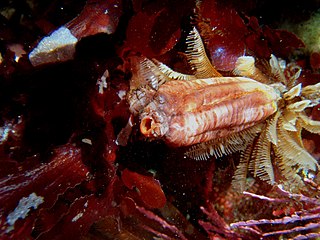
Ascidia is a genus of tunicates in the family Ascidiidae.

Pyura is a large genus of sessile ascidians that live in coastal waters at depths of up to 80 m (260 feet). Like all ascidians, Pyura are filter feeders. A few species, including Pyura chilensis are commercially fished.
Sorberacea were a monoorder and monofamilial class of benthic Tunicates. The single order of the class was Aspiraculata, and the single family of that order was Hexacrobylidae. In a taxonomic revision of the Tunicata in 2007, the name "Hexacrobylidae" was declared invalid and members of the family were included in the family Molgulidae in the class Ascidiacea.

Microcosmus is a genus of tunicates in the family Pyuridae, containing the following species:

Styela is a genus of tunicates. Styela clava, an edible species, is known as an invasive species in some areas.

Molgula, or sea grapes, are very common, globular, individual marine tunicates roughly the size of grapes.

Halocynthia is a genus of ascidian tunicates in the family Pyuridae. Species such as H. roretzi are eaten in parts of Asia as a delicacy.

Stolidobranchia is an order of tunicates in the class Ascidiacea. The group includes both colonial and solitary animals. They are distinguished from other tunicates by the presence of folded pharyngeal baskets. This provides the etymology of their name: in ancient Greek, στολίς, ίδος means the "fold" of a cloth. Stolidobranchian sea squirts are also characterized by the complete absence of an abdomen. The abdominal organs of other tunicates are instead located to one side of the pharyngeal basket in this group.

Aplidium is a genus of colonial sea squirts, tunicates in the family Polyclinidae. There are about 188 species in the genus found in shallow waters around the world.

Phallusia is a genus of tunicates of the family Ascidiidae, which includes the following species:

Polycarpa is a genus of ascidian tunicates in the family Styelidae.

Polyclinum is a genus of colonial sea squirts, tunicates in the family Polyclinidae.
Oligotrema is a genus of marine tunicates.
Paramolgula is a genus of marine tunicates.

Dendrodoa is a genus of ascidian tunicates in the family Styelidae.
Bostrichobranchus is a genus of ascidian tunicates in the family Molgulidae.
Minipera is a genus of ascidian tunicates in the family Molgulidae.
Protomolgula is a genus of ascidian tunicates in the family Molgulidae.

Corellidae is a family of sea squirts belonging to the order Phlebobranchia.

Corella is a genus of sea squirts belonging to the family Corellidae. The genome of Corella inflata has been sequenced which has provided insight into tunicate evolution














